
|
|
 |

|


 What in the HD World? What in the HD World?OLED TVs Have Landed
Dick De Jong August 24, 2013 HDTV Solutions The wait is over. The next big thing in TV technology has finally arrived. Both LG and Samsung have introduced 55-inch OLED HDTVs and for good measure, both screens sport a slight concave curve. Last month, the LG 55EA9800, priced at $14,999, was the first to grace our shores. About three weeks later, Samsung released the KN55S9C for a surprising $8,999. Ain't competition grand? 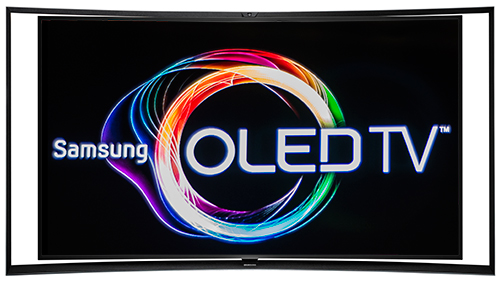 Last week, I had the opportunity to visit Samsung's QA Labs and take their impressive hot rod of an OLED TV for a spin. Before I detail that joyride, let me begin with a little historical context. I've been covering the HDTV beat for over seven years. Even back then a buzz was percolating about a new display technology that was going to blow away anything we had ever seen. In videophile forums, geeky friends, in conspiratorial tones, would whisper the magical acronym, OLED. And even if they all didn't quite understand the theory of organic light emitting diodes, they avowed it would leave LCD TVs (back lit by fluorescent tubes) in the dust. And in the heat of the conversation, one of the most devout might begin to hyperventilate and breathlessly state OLED TVs would outshine plasmas, even - as his voice turned reverential - even better than the holy standard of HDTVs, the Pioneer Kuro. So our OLED vigil began. Eagerly, we waited for the first sign of this game-changing technology. And in late 2007, Sony rewarded us with the first consumer OLED TV, the XEL-1. 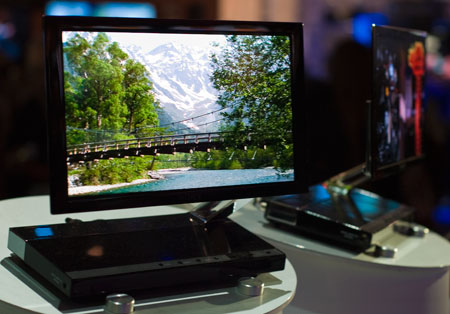 The Sony XEL-1 OLED TV on Display at CES 2008 The picture was eye-catching, at least what we could see on the XEL-1's 11-inch, 960 x 540 pixel, screen. Even more eye-popping was the $2500 price tag. But OLEDs had emerged out of the lab and into the marketplace. We figured it wouldn't be much longer before we would feast our eyes on a full-sized, full resolution OLED HDTV. We lit a candle and resumed our wait. We said confidently, at CES 2009, we'll see a big, bold OLED TV introduced. Alas, no. CES 2010 then, and once again, we were disappointed. As we plaintively inquired why, the response (after you strip away the tech-speak) simply was that it's not easy producing large OLED panels. And we were cautioned that the wait might be longer than we had hoped. Progress stands still for no technology and while OLED manufacturers were solving their challenges, LCD and plasma TV engineers relentlessly improved their displays. LEDs (that could be dimmed smartly) replaced fluorescents as LCD backlights and plasmas were tweaked to reproduce even richer colors and greater contrast ratios. Now with the rollout of these two OLED TVs, we can begin to see how this display technology stacks up to plasma and LED TVs. Do OLEDs maintain their once large theoretical superiority in picture quality? Or have plasmas and LEDs narrowed that gap in real-world situations? 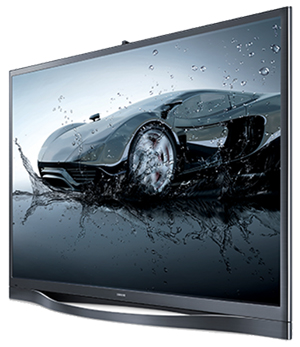
I was confronted with the possibility of that assessment when I entered the QA Labs viewing room. Sitting next to the presumptive king of the hill, the 55-inch OLED KN55S9C, was Samsung's highly regarded current picture quality champ, a Series 8500 plasma (picture on the right). Since they were both hooked to the same Blu-ray player, I was able to conduct an informal side-by-side visual comparison while watching Blu-rays like Avatar and Brave. From what I could see with my naked eye, I was hard pressed to discern any significant difference between the OLED and plasma TV. The picture quality of both were excellent. Before the OLED fans start screaming "blasphemy," I need to add this very important piece of information. I was later told that the two TVs had been tuned to output the same footcandles of light, which to an extent, handicaps some of the advantages that an OLED might exhibit over a plasma. When informed of that calibration, my question to the Samsung representative was how would you fine tune this OLED TV to showcase its attributes. The first suggestion was to reset it to its defaults. Which I did and the picture perked right up. 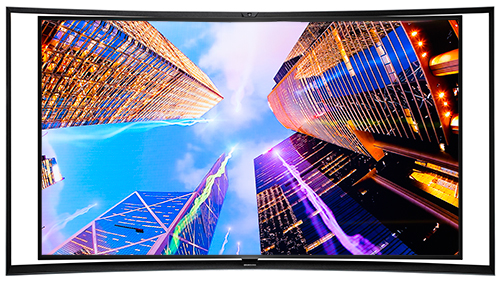 Also, if you change the Color Space setting to Native, the KN55S9C, through interpolation, will take the color range of the original signal and extend it to the wider color gamut possible with OLED displays. Therefore, I switched it to Native and I could perceive a slight change. To be fair to the Series 8500 plasma, it also has a Native setting. After tweaking the OLED, I will admit that it has a slight advantage in picture quality over the top of the line plasma. But is it enough to justify the $6500 difference between this 55-inch OLED and the 60-inch plasma? Before I address that, let me highlight a couple of other features that may tip the scales. First, one that might not be so obvious. The OLED panel has an extremely fast refresh rate. (The Samsung rep explained that they don't like to quantify it in the traditional Hz measurement.) A fast rate translates into a blur-free image, which for some can be hard to see. To really underscore the speed of the panel, the KN55S9C supplies a Multi View feature. The TV can playback two different programs simultaneously. Imagine this scenario, the husband wants to watch the football game and the wife prefers the Life of Pi. If each wears special glasses, they can see their program on the TV in full HD while their partner can enjoy theirs. And yes, the glasses include earphones that play their program's sound in stereo. 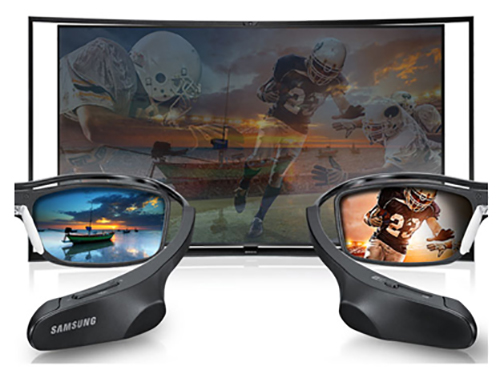 Multi View works. It may seem like a gimmick, but I could envision plenty of times when Multi View could placate potential familial flare-ups. Technologically, it's amazing that a panel is fast enough to generate two viewable images at once, which would be a hard task for any display other that an OLED. To emphasize the panel's swiftness, it is capable of reproducing two 3D programs at once. 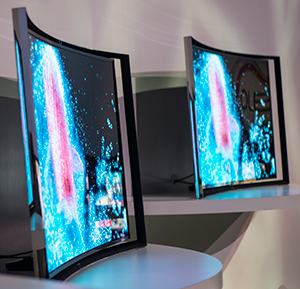
The second characteristic of this OLED KN55S9C, its stunning curved shape, is instantly more apparent. Actually, if you look closely, you will notice that the screen itself is not that curved. It's the arc of the frame that accentuates the concave aspect. The sweep is elegant, though mounting the TV might appear a bit odd since we are so accustomed to flat screens hugging the walls. To not distract from the clean aesthetic, Samsung designers have minimized the problem of multiple wires dangling from the TV. Instead of integrating multiple connections into the body of the TV, the KN55S9C is packaged with a One Connect box that furnishes the usual array of inputs. There is only one hybrid HDMI-like cable going from the One Connect to the OLED TV. It carries the audio and video signals to the TV and power back to the One Connect. The TV still needs to be plugged into a power outlet. Since you can attach an IR extender to the One Connect, the unit with its wires can then be located in a less conspicuous spot. Considering the inevitability of video software and hardware standards changing, the One Connect can be replaced with a new up-to-date model. If you are familiar with Samsung's Evolution box that attaches to the back of its plasma and LED TVs, the One Connect is the Evolution box for this OLED TV. Now to return to the question of a $9000 55-inch OLED TV or a $2500 top of the line plasma or LED TV, I think that for anybody with a limited bank account, the decision is simple. If you can comfortably afford the OLED premium, you will be rewarded with a stylish TV with superior picture quality and the bragging rights of an early adopter. For those of you anxiously waiting for a more down to earth price tag, the concept of production yield is a determining factor in the cost equation. As I mentioned, producing large OLED panels has been challenging. Basically for every ten that come off the production line, currently only a small percentage meet the standards. In other words, at this time, the production yield is low. When the yields go up, the price of the OLED TVs will come down. In fact, when asked how Samsung could charge $5000 less for their 55-inch OLED than LG, a Samsung executive alluded to improved production yield, though he gave no specific percentages. Of course, there are other factors involved in this game of oneupsmanship between these two Korean heavyweights, but as production yields rise, we should see more manufacturers compete in the OLED arena. After a long gestation, we are still in the birthing stage of OLED TVs. It should be fascinating to see how they mature. And if you are already anticipating the Next Big Thing, it's time to light a candle for the advent of an Ultra HD OLED TV. 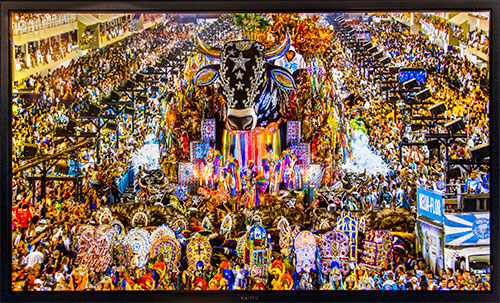 Sony's 56-inch 4K OLED Prototype TV Stay tuned. |
Bookmark:
![]() del.icio.us
del.icio.us
![]() Reddit
Reddit
![]() Google
Google
Reader Comments
Posted Aug 28, 2013 11:29:22 AM |
|
By Paul |
|
Posted Aug 27, 2013 11:04:54 AM |
|
By Dick De Jong |
|
In theory, a curved screen will make the pixels at the edge of the screen the same distance from your eye as the pixels at the center of the screen, which, once again in theory, will make the image on the screen consistently in focus.
You are correct about that advantage being more apparent on bigger screens. And no matter what the size of the display, there is a sweet spot seating distance away from the screen for maximum effect.
That sweet spot is calculated by the geometry of the curve and width of the screen. I asked the Samsung reps and they said for this 55-inch OLED, the distance is a little over 14 feet.
Since for most people, 14 feet is farther than they would normally sit from a 55-inch TV, the curve doesn't seem necessary.
Therefore, to answer your question, why a concave design, because they could. Beyond giving the TV a cool look, a curved screen adds another - very apparent - differentiator between OLED TVs and plasma or LED flat screens.
Posted Aug 25, 2013 8:27:15 PM |
|
By Paul |
|
| Send this Page | Print this Page | Report Errors |



Posted Feb 11, 2014 7:10:44 PM
By JayBass
And OLED large display technology is not old but infact very young and is still in its infancy as a specification thats still being developed and has not yet been standardised. There are so many areas of the OLED technology in general that is constantly changing because raw materials used in its current production keeps improving. 6 years ago if you tried to get 4 or 2 nanometer diameter metal oxides, bulk suppliers would laugh at you. That size of nano particle was only available in small quantities and from very specialised sources like testing facilities, labs and universities. Now you can place bulk mass tonnage orders on those sizes. Also the amount of different nano sized materials was also limited and now that nano technology has really mainstreamed new and improved materials allow manufacturers to explore even more production methods and thus improve improve productivity.
O you better believe it, the OLED technology already wipes rings around the LCD and Plasma counterparts and its going to improve even further. Because of nanoparticle based thin film OLED ha pretty much made electronic paper redundant. It can be manufactured at the same thin diameter, can bend as its also flexible, it has full color range and has no refresh rate limitations. They could even further reduce manufacturing costs for that type of application and not bother adding the color dye materials. So as a grayscale solution which costs considerably less to produce it still replaces e-paper. For those of you that don't know what e-paper is, the Wikipedia article on it is current. http://en.wikipedia.org/wiki/Electronic_paper
The production yield issues have pretty much already been resolved. And the reason the Samsung exec did not give you an idea as to production yield specifics is because they trashed the sensitive and expensive manufacturing process that produced their last offering and have abandoned the TFT backplane for the newer, more efficient higher yield and lower consumption method of LPTS backplane production which opens up even more avenues for Samsung to explore and reduces the cost and time of OLED manufacture by large amounts. Technology-wise Samsung are still leading the pack thanx to the amazing engineering intellects of people like Hong-Wei Chang, Jonghee Lee, Tae-Wook Koh, Seunghyup Yoo, S.D. Yambem, Won Mok Kim, Simone Hofmann, Malte C. Gather, Lars Müller-Meskamp, Karl Leo and many more who all constantly improve the OLED specification.